|
Module 48 |
Updated: 08/26/2005 |
|
Professional Although there's a rather blurry line separating professional and consumer formats, professional camcorders typically have the following features:
As you will see in this module, there is a bewildering number of professional videotape formats; in fact, some 15 are in common use today. Although this creates many problems with equipment and tape incompatibility, it also sparks the intense competition between manufacturers that leads to rapid improvements. First, it may be helpful to look at this comparison chart on the major quality differences between some of the more popular consumer and professional formats. Keep in mind that the greater the bandwidth (frequency in MHz) of the luminance part of the signal, and the greater number of horizontal lines of resolution, the clearer the video picture will initially appear to be.
Copying the video will change things. Beta SP, for example, will suffer more loss in the copying process than S-VHS. Now, let's take a look at some of the major professional recording
formats. |
|
One-Inch, Reel-to-Reel In an earlier module we mentioned
the two-inch tape that started the whole video recording process. After almost three
decades of use, the two-inch quad format gave way to one-inch With the one-inch Type C format, still-frame, slow- and accelerated-motion playbacks were possible for the first time. During the 1980s, Type C (shown here) was the dominant format in broadcasting and production facilities.
The first widely used cassette format was 3/4-inch U-Matic introduced in 1972. Although originally intended as a home and institutional format, because of its small size, it was soon adapted for broadcast field production in general and electronic newsgathering (ENG) in particular. However, since its quality was limited to 260 lines of resolution (sharpness), it was never considered a quality production format-even after the resolution was later increased to 330 lines. Even so, the 3/4-inch cassette format quickly replaced 16mm film in TV news. Like all of the cassette tape formats, 3/4-inch U-Matic cassettes
have a record lockout function to keep important The missing red button also explains why many people "couldn't get the recorder to work," until they found the problem and snapped in a new button.
All of the videotape formats we've
discussed have to cope with the possibly of momentarily interruptions in the flow
of data as the tapes are recorded and played back. A signal is recorded on the videotape in a data area the width of a human hair. The read-write heads spin across these areas at a speed of about 9,000 rpm (revolutions per minute). In an analog recording a small dust particle on the tape or an imperfection in the tape can cause dropouts (the momentary glitches shown here). A momentary head-to-tape separation of only four microns (which is 1/20th the size of a human hair) can cause a tape dropout. A speck of dirt or even a smoke particle from a cigarette is at least this size. To try to compensate for these problems, professional digital machines incorporate error correction circuitry. Simply put, these circuits keep track of the mathematical sums of the 0s and 1s in each block of digital data. If "things don't add up," these circuits substitute appropriate digital numbers (data). If a large block of data is corrupted, the circuitry will substitute data from previous data blocks. Taken to the extreme, if you lose a complete video frame, you will see the last good video frame frozen on the screen as the digital circuits keep using the previously uncorrupted data while awaiting uncorrupted data. Professional Digital Formats The "D" Formats There have been several successful formats in the "D" line. Sony developed D-1 in 1986. This was the first digital format and it made possible multi-generation editing without the loss in quality inherent in the analog formats. Although it has been largely replaced by more modern formats, D1 is considered a "no compromise" format where the color information is recorded separately from the luminance. D1 is still used in specialized postproduction applications where there's a need for extensive postproduction special effects. D-2, introduced by Ampex Corp., quickly followed D-1. This format uses compression. Although there is a slight loss in quality, the format greatly reduces technical demands. Matsushita (Panasonic) introduced D-3 in 1991. Since it uses a small 1/2-inch tape cassette, this format was used for the first digital camcorders. There is no D-4, since the term is similar for "death" in the Japanese language-and by this time almost all of the equipment was being manufactured in Japan. (Of course in the U.S. many buidings don't have a 13th floor and some airplanes don't have a 13th row.) Since D-3 wasn't as successful as Panasonic would Because D-5 has many technical advantages, this format made a definite impact in the high end equipment arena. D-5 is compatible with D-3. It uses 1/2-inch metal particle tape that will record up to 124 minutes on a single cassette. D-5 was the first format to rival the "no compromise" D-1 quality. It has been adopted by many high-end film transfer, graphics, and compositing special effects houses. D-5 also has the advantage of being able to handle demanding HDTV signals.
DVCPRO (D-7) uses the same sized tape as DV, and makes use of the quality advantages of metal particle tape. Many D-7 camcorders incorporate time-code capabilities. Even though DVCPRO offers many advantages, professionals still
wanted more, and so DVCPRO 50 was subsequently introduced.
Whereas the original DVCPRO used 4:1:1 sampling, DVCPRO 50 Other quality related characteristics, such as increased tape speed, were also instituted. DVCPRO 50 also handles the 16:9, HDTV aspect ratio. One of the advantages of DVCPRO is that the tape cartridges can be loaded into a special drive on a PC for editing. (Note photo on the right.) The content of the tape can be transferred to the computer's hard drive at four times normal speed.
Sony's DVCAM is a professional adaptation of the DV format and incorporates many of the same type of improvements used when DV was upgraded to DVCPRO. DVCAM incorporates the "iLink" (IEEE-1394) connection, which enables recorders to plug directly into computer-based editing systems. DVCAM machines can play back the DV and DVCPRO formats. Digital Betacam
was introduced by The format was based on a 1/2-inch tape format pioneered by companies such as Grundig and Phillips. (A Betacam cassette is shown on the left.) Although Digital Betacam can't record Betacam SP tapes, it can play them back. Digital Betacam can handle the 16:9 format. In a similar way that users pushed Panasonic to improve DVCPRO by introducing DVCPRO 50, Digital Betacam users had concerns that prompted Sony to introduce Betacam SX in 1996. However, the MPEG-2 compression used with SX requires special considerations in editing. You may remember that we discussed this issue in an earlier module.
Digital-S, was designed as a professional upgrade to S-VHS. When the standard was officially accepted by the SMPTE standards committee to become the D-9 format, it found its way into professional applications. D-9 has a pre-read function that incorporates the simultaneous use of separate record and playback heads. This makes it possible to see (check) the recorded signal a split-second after it's recorded. In addition, pre-read enables users to playback a signal and add titles or effects, and immediately record the combined effect. Some users can assemble an A/B roll interview "on the fly" with only two D-9 machines, thus eliminating normal editing procedures.
We introduced the concept of camcorders that record on internal computer hard drives in the last module. However, at the professional level a number of additional features are incorporated into these machines. One model, introduced in mid-2003, allows you to record two channels of video and audio, while simultaneously playing back two channels. This makes it possible to do basic editing "in the camera," with an almost instant access to the scenes.
Two recording techniques have been introduced that will undoubtedly speed the demise of videotape: blue laser DVD recording and solid-state memory-based PCMCIA cards. (The latter are solid-state memory cards that slide into PCMCIA slots in camcorders and computers.) In late 2002, Hitachi introduced a tapeless
acquisition format that records both in solid-state
Sony's DVD system uses a blue laser light to record up to 23.3Gb of data on a single 5 inch (12.7cm) DVD camcorder disc. This translates into over an hour of broadcast quality audio and video. Like any DVD recording, it's possible to almost instantly move to any point in a recording. The recordable DVDs can be used multiple times. Panasonic introduced P2 professional grade solid-state recording in 2004. Their AJ-SPX800 camcorder has no moving parts and has slots for up to five memory cards.
This "no moving parts" approach is highly resistant to environmental problems, such as humidity and vibration. Plus, it uses far less power than videotape or DVD camcorders. There are two more advantages to
using solid-state memory: some models allow for However, for practical, day-to-day professional use, the professional versions of solid-state SD cameras are much larger - about the size of today's videotape camcorders. Solid-state memory cards have proven themselves in digital still cameras for a number of years. They can be re-recorded up to 100,000 times, which means that they have a much longer useful life than videotape or even recordable DVDs.
The first high-definition digital recorder was Sony's HDD-1000. It is an uncompressed recorder that used 1-inch, open reel tape (which, incidentally, cost $1,500 for a one-hour reel). Not unexpectedly, perhaps, these machines weren't big sellers, and they were soon replaced by HDCAM. We previously These D-5 machines can record HDTV signals in either the 720p or 1080i-line resolutions. Likewise, the DVCPROHD is an upgraded version of DVCPRO. However, the tape speed has been increased to four-times that of DVCPRO, which give you some idea of the extra demands on all of these machines to handle HDTV signals. While we're talking about HDTV cameras we should mention that HDTV cameras have now reached down into the consumer market. In late 2003, JVC introduced the first consumer HDTV camera, the GR-HD1. It uses mini-DV tapes. The camcorder costs about $3,500, or a fraction of what today's professional HDTV cameras cost. The camcorder comes with editing software and brings superior quality HDTV images within the reach of many consumers and small production facilities. In fact, a number of documentaries that have ended up on network TV have originated with this camera. In mid-2005 Sony introduced their own HDTV consumer/prosumer-level camcorders.
At the other end of the HDTV price-quality
Although film directors often cite the superior exposure latitude of film, cameras such as this can match the latitude of most motion picture film stocks. Instead of using the 2/3 inch chip that's common to most professional video cameras, the DALSA uses a chip with an image area many times greater - roughly the size of a 35mm motion picture image. This has many advantages, including the ability to use standard motion picture camera lenses. These cameras (along with their uncompressed 4:4:4 video outputs) are now being used for major motion pictures. In the next Module we'll take up video recorder operations. |

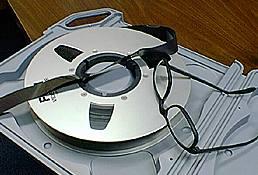 tape.
Initially there were "Type A" and "Type B" versions of the one-inch format. But,
it was the Type C version that became the next major standard, especially in countries
using the NTSC video standard.
tape.
Initially there were "Type A" and "Type B" versions of the one-inch format. But,
it was the Type C version that became the next major standard, especially in countries
using the NTSC video standard. material from being accidentally erased. When the red button (shown in the
photo on the right) is removed, machines will not record on the tape.
material from being accidentally erased. When the red button (shown in the
photo on the right) is removed, machines will not record on the tape.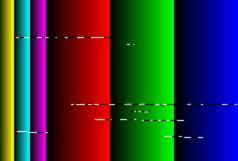 It's easy to see why such interruptions can occur.
It's easy to see why such interruptions can occur.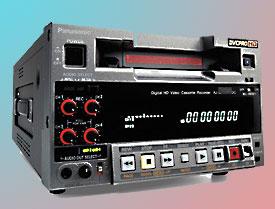 have liked, they introduced D-5 in 1993, in
part to compete with Sony's popular digital Betacam.
have liked, they introduced D-5 in 1993, in
part to compete with Sony's popular digital Betacam.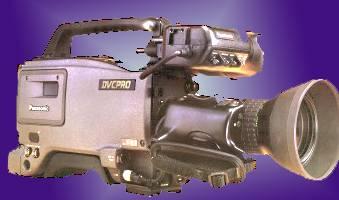 D-7,
or DVCPRO was Panasonic's way of moving the advantages
of the small DV and DVC formats up to a professional level.
D-7,
or DVCPRO was Panasonic's way of moving the advantages
of the small DV and DVC formats up to a professional level. samples
at the higher 4:2:2 level.
samples
at the higher 4:2:2 level.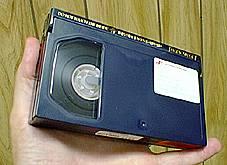 Sony
in 1993 as a digital replacement for their very popular analog Betacam line introduced
20 years earlier.
Sony
in 1993 as a digital replacement for their very popular analog Betacam line introduced
20 years earlier. computer RAM and on a DVD. This combination make it possible to easily record and
edit projects in the field.
computer RAM and on a DVD. This combination make it possible to easily record and
edit projects in the field.
 Once
video is recorded, the card can be removed and placed in a computer for editing.
Once
video is recorded, the card can be removed and placed in a computer for editing.
 playbacks and digital uploading to editing systems at 20X normal speed, and the
camcorders can be made extremely small-so small, in fact, that you can close
your hand around one consumer model.
playbacks and digital uploading to editing systems at 20X normal speed, and the
camcorders can be made extremely small-so small, in fact, that you can close
your hand around one consumer model. mentioned
the D-6 format, so we'll move onto D-5HD, which as you
might guess, is an HDTV version of Panasonic's D-5 line.
mentioned
the D-6 format, so we'll move onto D-5HD, which as you
might guess, is an HDTV version of Panasonic's D-5 line.  continuum
is a camera made by DALSA that produces pictures with four times the resolution
of the best 2005 HDTV cameras.
continuum
is a camera made by DALSA that produces pictures with four times the resolution
of the best 2005 HDTV cameras.